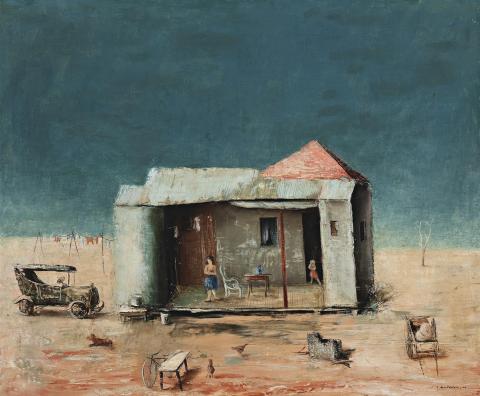OUTBACK, 1946
SALI HERMAN
oil on canvas on composition board
51.5 x 61.5 cm
signed and dated lower right: S Herman. 46
Sydney Ure Smith, Sydney
Thence by descent
Ure Smith collection, Sydney
Deutscher and Hackett, Sydney, 2 December 2015, lot 11
Private collection, Melbourne
The Wynne Prize, Art Gallery of New South Wales, Sydney, 1946 (bears inscription on label verso: Winne [sic] Prize competition: / Artist: S Herman / title: ‘Outback’)
Sali Herman Retrospective, Art Gallery of New South Wales, Sydney, 1 – 26 July 1981, cat. 29 (label attached verso), and touring nationally from September 1981 – July 1982 to State and Regional galleries
Ure Smith, S. (ed.), Present Day Art in Australia, Ure Smith Publishing, Sydney, 1949, p. 48 (illus.)
Art and Australia, vol. 3, June 1965, p. 80 (illus.)
Thomas, D., Sali Herman, Collins, Sydney, 1971, pl. 20, p.111 (illus.)
Pearce, B., Sali Herman: Retrospective, Art Gallery of New South Wales, Sydney, 1981, cat. 29, p. 49 (illus.)
Such was the reach of Sali Herman’s work, that there was a time when almost every pub in New South Wales seemed to have a reproduction of his House on the Hill, 1948 hung in a prominent place. Without a doubt this widely reproduced image would have introduced many Australians to the work of Sali Herman, and it is his paintings of Sydney’s post-war street scenes that are his most recognisable works.
In 1945 Herman was awarded the Wynne Prize for landscape painting and also had a work purchased for the National Art Gallery of New South Wales collection. He then accompanied the gallery’s Travelling Art Exhibition service on a tour across western New South Wales as a lecturer. This afforded him the chance to observe firsthand the hardship being experienced by drought stricken outback Australians at that time. The drought was to last ten years and was responsible for much hardship and heartache, but also inspired several paintings that are widely regarded as masterpieces of Australian art.
Outback, 1946 fits neatly in Herman’s oeuvre alongside his steadfast commitment to depicting the dwellings of inner Sydney workers. Herman’s depictions of working class ‘Sydney slums’ sat comfortably with his leftist ideals which he formed during his time travelling in Europe between the two world wars. Paris in particular enabled him to mix with revolutionary writers and artists. The political ferment of that time stayed with the artist throughout his life.
His participation in exhibitions with the Studio of Realist Art offered a sympathetic environment in which to express his socialist ideals. Herman’s paintings have been seen by many as paying homage to the struggles of Sydney’s underclass following WWII. His 1944 Wynne Prize winning painting McElhone Stairs, 1944, was said to represent labour and hardship, as the artist chose to depict the figures dwarfed by the stairs which appear to get steeper as they rise.
In Outback the heroes of the painting are clearly the family, as the mother and child occupy the dwelling and appear to be waiting for the return of the male bread winner. This depiction of a scene on the road to Broken Hill shows a typical outback family of the period. Having to travel in search of work the father is absent for long stretches. The chickens wander, the dog keeps vigil the car is redundant and serves only to amplify the remoteness of the scene. A water tank looms large over the dwelling like a lung crucial to the survival of the family; a bucket sits under the tap to ensure nothing gets wasted.
Outback depicts the adversity faced by stoic outback Australians who demonstrated a stubborn resilience in the face of relentless hardship. We empathise with the outback characters; we see them as battlers in the face of overwhelming odds, an idea that is central to the image many Australians have of themselves.
HENRY MULHOLLAND
